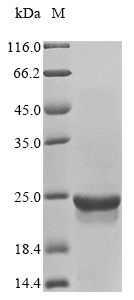The region for expressing recombinant Human MTOR contains amino acids 2012-2144. The expected molecular weight for the MTOR protein is calculated to be 23.2 kDa. Expression of this MTOR protein is conducted in e.coli. The MTOR gene fragment has been modified by fusing the N-terminal 10xHis tag and C-terminal Myc tag, providing convenience in detecting and purifying the recombinant MTOR protein during the following stages.
The human serine/threonine-protein kinase mTOR is a key regulator of cellular processes, integrating signals from various pathways to control cell growth, proliferation, and metabolism. mTOR exists in two distinct complexes, mTOR Complex 1 (mTORC1) and mTOR Complex 2 (mTORC2), each with specific functions. mTORC1 regulates protein synthesis, cell growth, and autophagy in response to nutrient availability and growth factors. mTORC2 influences cell survival, cytoskeletal organization, and metabolism. Dysregulation of mTOR signaling is implicated in various diseases, including cancer and metabolic disorders. Targeting mTOR has therapeutic implications, making it a prominent focus in cancer research and drug development. Understanding mTOR's intricate functions contributes to insights into cellular homeostasis and disease mechanisms.






